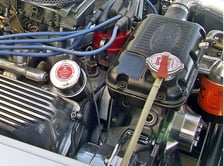With tight budgets, track rules and other build limitations, knowing what components to include or omit on your build can be difficult. Performance upgrades are always at the top of the modifications wish list. However, as you add performance and push the limitations of your car it is important to support those upgrades with the right components.
A recovery tank can often be one of those components that needs to be considered. But how do you know if you need one?
To determine if you need a recovery tank you will first need to take a look at your coolant system's method for relieving pressure. Pressure in coolant systems are typically regulated at their highest point through a pressure relieving cap in an expansion tank or a relief barb in the radiator. The pressure relief not only relieves excessive system pressure, but also allows excess air that has accumulated to be pushed out of the system. This is important as air pockets can cause inconsistencies in the cooling system. However, as the pressure relief vents air it may also expel coolant. A recovery tank's basic job is to catch this coolant.
If your coolant system is relieving pressure from a relief barb on the radiator, we would almost always recommend a recovery tank. Even if your radiator is designed to allow for a pocket of air at it's top, you will likely be discharging some coolant when your system is up to temperature.
If your using an expansion tank for relieving system pressure your need for a recovery tank will depend on the design of the expansion tank you have. Some tanks are designed to vent under the cap and provide no means to plumb a recovery tank. Those tanks are generally not intended to be used with a recovery tank. Some expansion tanks have relief barbs much like those in radiators which can be easily plumbed to a recovery tank.
If you have an expansion tank with a relief barb, then consider the size and current function of the tank. If your tank is large enough and holds enough air volume for the coolant to expand without overflowing, then only air, not coolant, should be discharging from the pressure relief. In this case, there is no need for a recovery tank.
If your expansion tank is on the smaller side, or your coolant tends to run hot and needs more expansion room, or you just want to be sure your never loosing coolant out of your system, then you should install an recovery tank.
Whether you have a coolant system with an expansion tank or one that features a relief barb on the radiator there are two main advantages to running a recovery tank.
The first advantage to running a  recovery tank is that it keeps fluids from being expelled onto the ground. A recovery tank will capture the fluid that is expelled as the cooling system heats up. In a track situation this will keep you from getting pulled off the track for dropping fluid.
recovery tank is that it keeps fluids from being expelled onto the ground. A recovery tank will capture the fluid that is expelled as the cooling system heats up. In a track situation this will keep you from getting pulled off the track for dropping fluid.
The second advantage to a recovery tank is making sure that the coolant system is operating at max capacity. By having a recovery tank you can ensure that the coolant system has the max volume of coolant in it. The capacity of the pressurize side of your coolant system is largely dictated by how hot your engine is going to get. The hotter it gets the more coolant expands. The more the coolant expands the more it will push out of the pressure relief. By running a recovery tank you will be able to reintroduce the expelled coolant into the system as it cools down.
In the event that you are looking for an .jpg?width=221&name=80-203-Internals-(4).jpg) expansion tank and also want to run a coolant recovery tank without having to plumb in new lines we have a two in one option available, our 80-203 tank. Click the image to see the listing. One side is an expansion tank that can be pressurized and features an internal pressure relief that feeds the recovery side of the tank.
expansion tank and also want to run a coolant recovery tank without having to plumb in new lines we have a two in one option available, our 80-203 tank. Click the image to see the listing. One side is an expansion tank that can be pressurized and features an internal pressure relief that feeds the recovery side of the tank.
If you haven't yet read our Expansion vs Recovery blog click here. That blog post goes more into depth in regards to the different types of tanks that can be used and how to tell which one you need.

